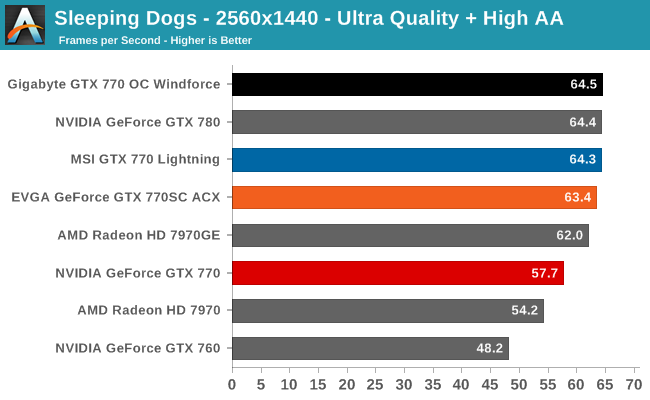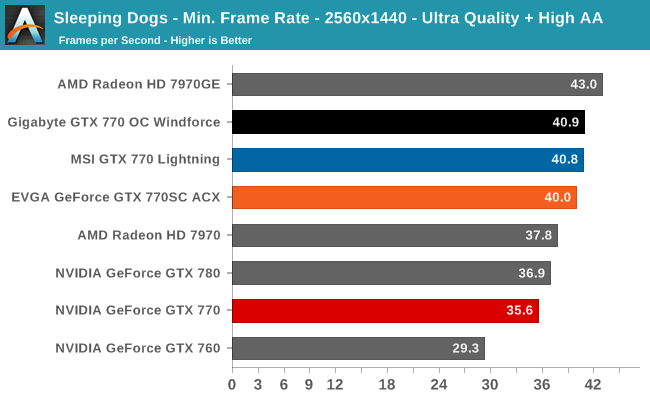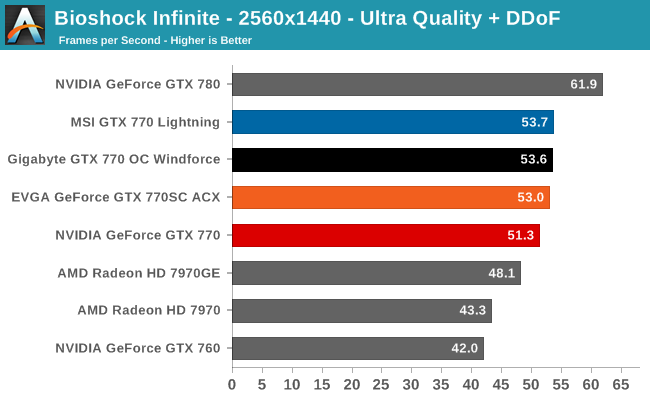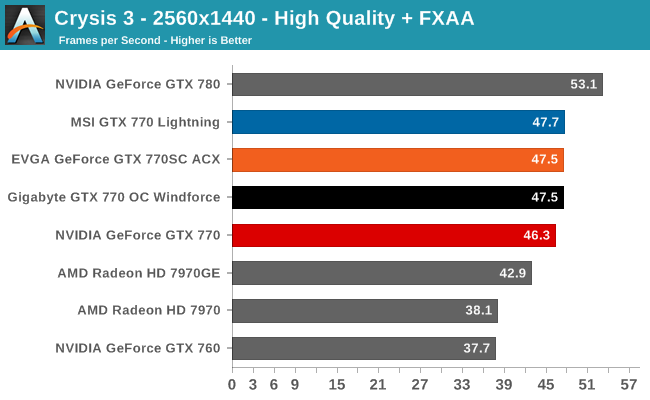The GeForce GTX 770 Roundup: EVGA, Gigabyte, and MSI Compared
by Ryan Smith on October 4, 2013 9:00 AM ESTSleeping Dogs, Bioshock, & Crysis 3


Moving on to Sleeping Dogs and its resource heavy SSAA implementation, we finally see the factory overclocks on these cards start to spread their wings, and in the process we see the cards separate themselves a bit. The fastest card by a nose is the Gigabyte 770OC Windforce, which picks up 11%. This is actually better than the Gigabyte overclock, which points to thermals also playing a factor. The MSI card follows, also at 11%, and finally the EVGA card 1fps back at 10%. It’s unfortunate for all 3 vendors that their factory overclocks aren’t this potent in every game, as these are the kind of results that help their customized cards stand out.

With Bioshock we’re back into the previous pattern of limited performance gains over a stock GTX 770, again likely due to memory bandwidth limitations. Gigabyte is once more technically the leader of the pack at 4%, but with EVGA and MSI only .2fps back it’s for all practical purposes a tie.

Our final game, Crysis 3 matches our earlier pattern of very limited gains over the stock GTX 770. At 47.7fps, the MSI GTX 770 Lightning takes an insignificant .2fps lead over the other cards in this roundup, with the overall performance gains amounting to just 3% over a stock GTX 770.
What’s clear from all of this is that EVGA, MSI, and Gigabyte are not going to be able to sell themselves on their factory overclocks alone. There are performance gains to be had, but outside of one game (Sleeping Dogs) the gains are only a few percent, which translates into just a frame or two per second in most cases. The fact that EVGA and Gigabyte aren’t charging extra for their designs is in retrospect a wise move here, as it would be difficult to charge anything meaningful for these factory overclocks given the very small performance increases. At least as far as stock performance is concerned, to differentiate themselves all 3 companies will need to rely on differentiation in their coolers, software, and support.










55 Comments
View All Comments
MarcHFR - Saturday, October 5, 2013 - link
Hi RyanTwo question
- 38 dBA is very high for idle. What's the measuring distance ? Background noise with computer off ? Noise of the computer with fanless graphic card ?
- What are the model of 7970 and 7970 GHz tested ?
Thans a lot !
Ryan Smith - Saturday, October 5, 2013 - link
1) It's fairly close; under a foot. The idea isn't so much to measure absolute noise as to compare and rank cards.2) Reference 7970. HIS IceQ X2 7970 GHz Edition.
MarcHFR - Sunday, October 6, 2013 - link
Thanks, so less than one foot from the closed Thermaltake Speedo, that's it ?And what about background and computer (without active graphic card) noise ? What is the sound-level meter used ? Thanks
PC Perv - Saturday, October 5, 2013 - link
It is interesting to see how far the custom cooling solutions (and custom PCBs) have come on video cards. I know it is nothing new and obviously marketing-driven, but nevertheless gives consumers more choices and better experiences.Thank you for thorough review, Ryan.
PC Perv - Saturday, October 5, 2013 - link
Even betweein the same OEM's cooler's, I see how they "evolved." For instance, Gigabyte's WindForce had quite a few shortcomings at first - no heatsinks on memory/VRMs, fan rattling and getting worse over time, etc. It's great to see that they are learning and improving.Slomo4shO - Sunday, October 6, 2013 - link
I would love to see an expansion to the OC section of these reviews and having OC figures for the comparison cards as well (760, 780, 7970, and 7970GE). Can you or whoever is writing up the review the upcoming R9 280X also include the OC benchmarks of the 770s in the overclock section of that review?marraco - Sunday, October 6, 2013 - link
Something that would be very useful and valuable for differentiation purposes would be a card easy to clean. All of my cards get his radiators completely occluded with dust from time to time, and cleaning them is incredibely annoying.I wish it could be as easy as trowing the radiator and fans to the dishwasher. But it never is as simple. I don't dare to wet my fans, because they are not detachable from the engines. And removing the radiator mean having silicone paste to reinstall them. Frequently I don't ever have silicone paste. I need to buy more, and that's a delay, and an impediment to clean the cards at convenient times.
Same goes for CPU and power refrigeration systems.
ShieTar - Monday, October 7, 2013 - link
Is there any chance to add an SLI of 2x GTX 760 to this round of benchmarks? This option costs less than a GTX780, but has the potential of out-performing a Titan. Therefore it would be very interesting to see how it performs in reality.The Warden - Sunday, November 3, 2013 - link
Ryan, can you tell me if this GTX 770 would be a good choice to replace my very old ATI Radeon HD 2600 XT for the specific purpose of improving my Final Cut Pro editing processes? I just don't know if the graphics cards play that big a roll in the editing displays and playback for Final Cut, and if I am just fine with what I have.Chloiber - Thursday, November 21, 2013 - link
I'm really disappointed by the EVGA card. I currently own a 770 SC ACX. It's loud in idle (fan won't go below 1400rpm), it's pretty loud under load. Why do I even buy a custom card? For the 50MHz higher boost?They clearly forgot what a custom card is all about. You can get a silent BIOS from the support which reduces the idle fan speed to 1100rpm. Still way too loud for my taste.
Same goes for the ASUS DC2OC by the way. It's quieter in idle, but fans won't go below 1100rpm.